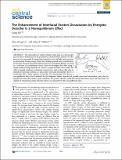The Enhancement of Interfacial Exciton Dissociation by Energetic Disorder Is a Nonequilibrium Effect
Author(s)
Shi, Liang; Lee, Chee Kong; Willard, Adam P.
Downloadacscentsci.7b00404.pdf (2.382Mb)
PUBLISHER_POLICY
Publisher Policy
Article is made available in accordance with the publisher's policy and may be subject to US copyright law. Please refer to the publisher's site for terms of use.
Terms of use
Metadata
Show full item recordAbstract
The dissociation of excited electron-hole pairs is a microscopic process that is fundamental to the performance of photovoltaic systems. For this process to be successful, the oppositely charged electron and hole must overcome an electrostatic binding energy before they undergo ground state recombination. It has been observed previously that the presence of energetic disorder can lead to a reduction in recombination losses. Here we investigate this effect using a simple model of charge dynamics at a donor-acceptor interface. We consider the effect of spatial variations in electronic energy levels, such as those that arise in disordered molecular systems, on dissociation yield and demonstrate that it is maximized with a finite amount of disorder. We demonstrate that this is a nonequilibrium effect that is mediated by the dissipation driven formation of partially dissociated intermediate states that are long-lived because they cannot easily recombine. We present a kinetic model that incorporates these states and show that it is capable of reproducing similar behavior when it is parametrized with nonequilibrium rates.
Date issued
2017-12Department
Massachusetts Institute of Technology. Department of ChemistryJournal
ACS Central Science
Publisher
American Chemical Society (ACS)
Citation
Shi, Liang et al. “The Enhancement of Interfacial Exciton Dissociation by Energetic Disorder Is a Nonequilibrium Effect.” ACS Central Science 3, 12 (December 2017): 1262–1270 © 2017 American Chemical Society
Version: Final published version
ISSN
2374-7943
2374-7951